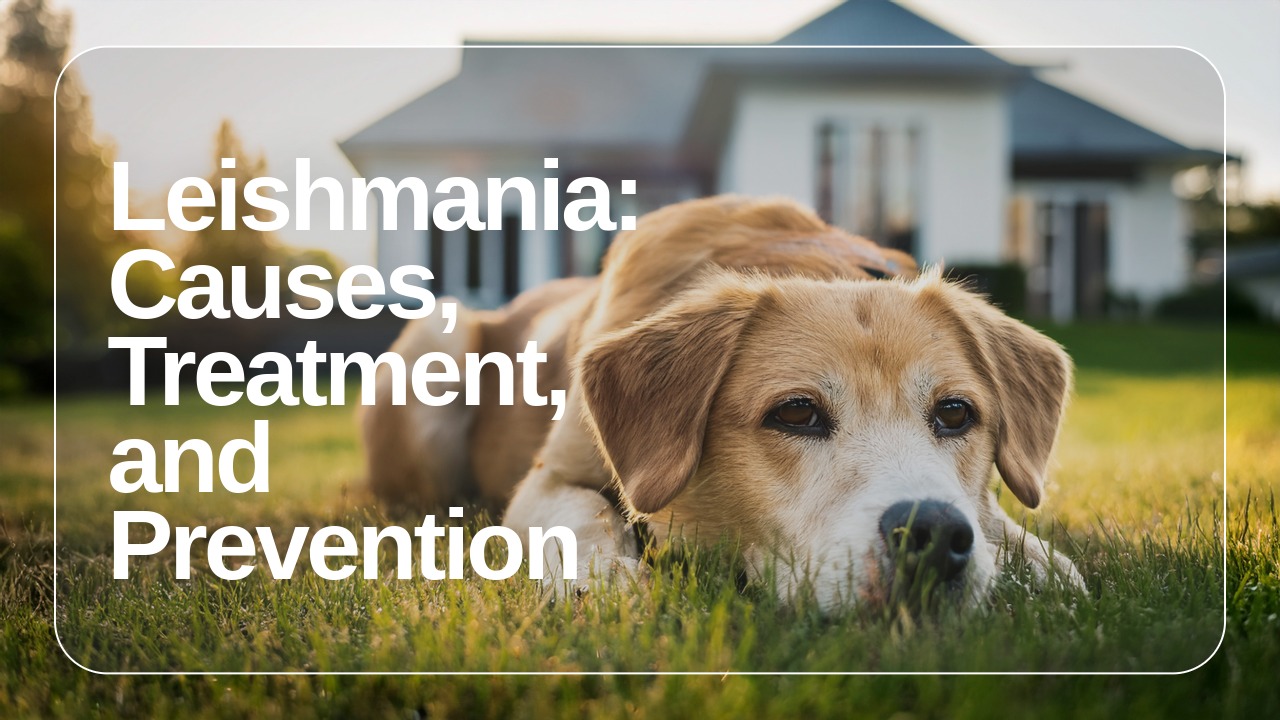published on: 03.07.2025

Leishmania in Dogs – Causes, Treatment, and Prevention
Discovering your dog might have Leishmania can be scary, but understanding the disease is the first step toward managing it effectively. This guide breaks down what canine leishmaniasis is, how dogs get it, and the most current approaches to treatment and prevention. With the right care plan, many dogs can live long, comfortable lives.
Key Takeaways
- What It Is: Canine leishmaniasis is a disease caused by the Leishmania infantum parasite, which is transmitted by the bite of an infected sand fly.
- Common Signs: Key symptoms include skin sores, unexplained weight loss, and enlarged lymph nodes. Internally, it can cause severe kidney damage.
- How It's Treated: Treatment usually involves a combination of medications like meglumine antimoniate or miltefosine along with allopurinol to control the parasite.
- Prevention Is Crucial: The best defense is preventing sand fly bites using special insecticide collars, spot-on treatments, and keeping dogs indoors during dusk and dawn.
- Long-Term Management: Leishmaniasis is often a chronic condition that is managed, not cured. Regular vet check-ups are essential to monitor for relapses.
What Is Canine Leishmaniasis?
Canine leishmaniasis is a serious parasitic disease caused by a microscopic organism called Leishmania infantum. The primary way dogs get this disease is through the bite of an infected female phlebotomine sand fly. Once the parasite enters a dog's body, it can spread and cause a wide range of problems. The infection often targets the skin, leading to persistent sores, hair loss (especially around the eyes), and cracked paw pads. It can also invade internal organs, including the lymph nodes, spleen, bone marrow, and kidneys. When the kidneys are affected, the disease becomes much more severe. Because the signs can be slow to develop and worsen over time, early diagnosis and treatment are critical to managing the parasite's impact and giving your dog the best possible outcome.
Diagnosis: How Your Vet Identifies Leishmania
Confirming a leishmaniasis diagnosis requires a careful and methodical approach from your veterinarian. The process starts with a discussion about your dog's history, particularly if you live in or have traveled to an area where sand flies are common. A thorough physical exam will check for classic signs like skin lesions, swollen lymph nodes, or pale gums. To get a definitive answer, your vet will run specific diagnostic tests. Common tests include serology (like an ELISA test) to detect antibodies your dog’s immune system has made against the parasite, or a PCR test to find the parasite's genetic material. Additionally, blood chemistry panels and urinalysis are vital for assessing organ function, especially the kidneys. This information helps your vet not only confirm the infection but also determine its severity, which guides the entire treatment plan. [1]
Modern Treatment Protocols for Infected Dogs
Treating canine leishmaniasis is focused on controlling the parasite and managing symptoms, as a complete cure is rare. The most effective strategies involve combination therapy to reduce the parasite load and keep it suppressed long-term. Your veterinarian will choose a protocol based on your dog's health, especially their kidney function. These treatments are backed by extensive research and are considered the standard of care by veterinary experts. [2]
Common Treatment Options
| Treatment Combination | Administration Details | Primary Use Case |
|---|---|---|
| Meglumine antimoniate + Allopurinol | A 28-day course of injections combined with oral allopurinol for at least six months. | Considered a first-line therapy with a high success rate in reducing parasite numbers. [3] |
| Miltefosine + Allopurinol | A 28-day course of an oral liquid medication, followed by long-term allopurinol. | A great alternative when daily injections are not practical for the owner. |
| Allopurinol (alone) | Oral medication given long-term. | Used for mild cases or as a maintenance therapy after an initial combination treatment to prevent relapse. |
Prevention and Long-Term Management
Preventing your dog from getting infected in the first place is the most effective strategy against leishmaniasis. This involves creating a barrier between your dog and sand flies, which are most active from spring through fall, especially at dawn and dusk. Using a 4% deltamethrin-impregnated collar or a permethrin-based spot-on treatment is highly effective at repelling and killing sand flies before they can bite. [4] Keeping your dog indoors during peak sand fly activity hours also significantly reduces their risk. For dogs that have already been treated, the journey isn't over. Leishmaniasis is a chronic condition, and relapses are common. Therefore, life-long management is key. This includes regular veterinary check-ups every 3-6 months to monitor for any return of symptoms and, in many cases, continued low-dose allopurinol to keep the parasite suppressed.
Frequently Asked Questions (FAQ)
- Can I get leishmaniasis from my dog?
- Direct transmission from a dog to a human is extremely rare and not considered a significant risk. The disease is spread by the bite of an infected sand fly, which can bite both dogs and humans. Your dog is a reservoir for the parasite, not a direct source of infection for you.
- Is the treatment for leishmaniasis expensive?
- The cost can be significant. It includes the initial diagnostic tests, the medications (which can be long-term), and frequent follow-up blood work and vet visits to monitor organ function and check for relapse. Costs will vary based on your location and your dog's specific condition.
- How long can a dog live with leishmaniasis?
- With proper diagnosis, treatment, and long-term management, many dogs can live a normal lifespan. The prognosis is best when the disease is caught before severe kidney damage occurs.
- Is leishmaniasis only found in certain parts of the world?
- While it is most common in Mediterranean countries, the Middle East, and parts of Latin America and Asia, the disease is spreading. With increased international pet travel, cases are now seen in regions where it was not previously found, including North America.
References
- LeishVet. Field Guide to Canine Leishmaniosis – 2024 Update. https://www.leishvet.org/wp-content/uploads/2024/04/FS-ALIVE24-canine.pdf
- Paltrinieri et al. “Clinical and Laboratory Response of Dogs Treated with Miltefosine + Allopurinol,” Pathogens, 2023. https://www.ncbi.nlm.nih.gov/pmc/articles/PMC10610677/ (NIH - .gov affiliated)
- Mosteiro et al. “Critically Appraised Topic on Canine Leishmaniosis,” Veterinary Sciences, 2024. https://www.mdpi.com/2306-7381/11/6/231
- “Insecticide-Impregnated Dog Collars for VL Control,” Parasites & Vectors, 2024. https://parasitesandvectors.biomedcentral.com/articles/10.1186/s13071-024-06474-4
Come over for a visit at 77 Sulkhan Tsintsadze St, Tbilisi
Or call Us +995 599 996 487
